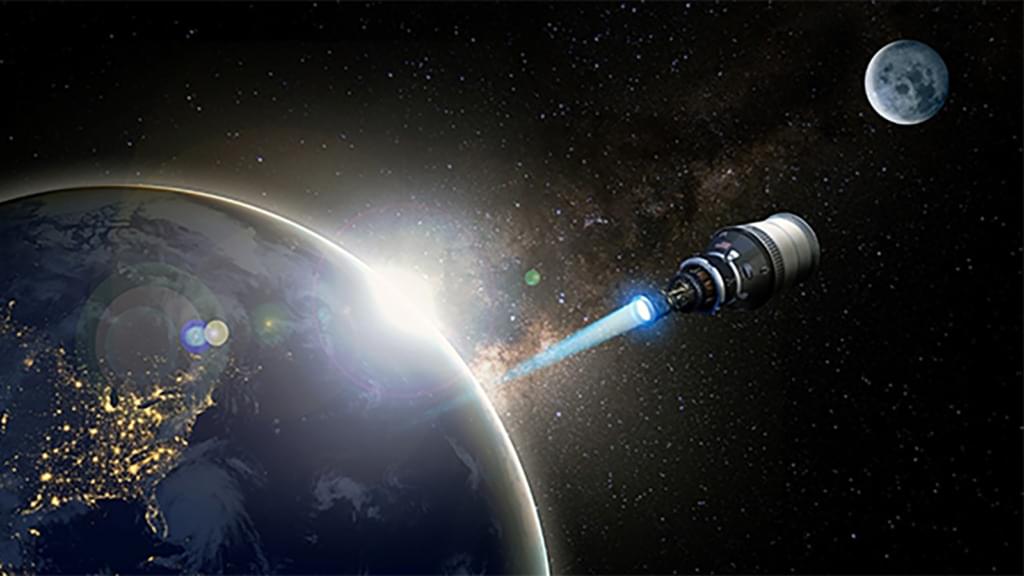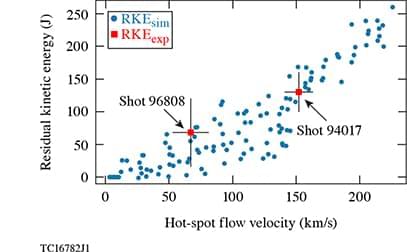DRACO began life in 2020 with the moniker “Reactor on a Rocket,” or ROAR — a name agency scientists later decided might garner negative attention.



Scientists at the University of Oxford have unveiled a pioneering method for capturing the full structure of ultra-intense laser pulses in a single measurement. The breakthrough, published in close collaboration with Ludwig-Maximilian University of Munich and the Max Planck Institute for Quantum Optics, could revolutionize our ability to control light-matter interactions.
This would have transformative applications in many areas, including research into new forms of physics and realizing the extreme intensities required for fusion energy research. The results have been published in Nature Photonics.
Ultra-intense lasers can accelerate electrons to near-light speeds within a single oscillation (or ‘wave cycle’) of the electric field, making them a powerful tool for studying extreme physics. However, their rapid fluctuations and complex structure make real-time measurements of their properties challenging.
A Los Alamos collaboration has replicated an important but largely forgotten physics experiment: the first deuterium-tritium (DT) fusion observation. As described in the article published in Physical Review C, the reworking of the previously unheralded experiment confirmed the role of University of Michigan physicist Arthur Ruhlig, whose 1938 experiment and observation of deuterium-tritium fusion likely planted the seed for a physics process that informs national security work and nuclear energy research to this day.
“As we’ve uncovered, Ruhlig’s contribution was to hypothesize that DT fusion happens with very high probability when deuterium and tritium are brought sufficiently close together,” said Mark Chadwick, associate Laboratory director for Science, Computation and Theory at Los Alamos. “Replicating his experiment helped us interpret his work and better understand his role, and what proved to be his essentially correct conclusions. The course of nuclear fuel physics has borne out the profound consequences of Arthur Ruhlig’s clever insight.”
The DT fusion reaction is central to enabling fusion technologies, whether as part of the nation’s nuclear deterrence capabilities or in ongoing efforts to develop fusion for civilian energy. For instance, the deuterium-tritium reaction is at the center of efforts at the National Ignition Facility to harness fusion. Los Alamos physicists developed a theory about where the idea came from—Ruhlig—and then built an experiment that would confirm the import and accuracy of Ruhlig’s suggestion.

In this engaging new eighth episode of the AI Bros podcast, hosts John Lawson III and Bruce Burke delve into the dynamic world of artificial intelligence and its profound impact on various industries. The conversation kicks off with a discussion on the latest developments in AI, highlighting the massive investments being made by tech giants like Mark Zuckerberg, who recently acquired a significant stake in Scale AI. This move underscores the growing importance of data labeling in training AI models and the relentless pursuit of achieving Artificial General Intelligence (AGI).
The hosts explore the implications of AI on global infrastructure, particularly focusing on the energy demands required to support AI advancements. They discuss the necessity of building new data centers and the potential role of nuclear energy in meeting these demands. The conversation touches on the strategic moves by companies to secure energy resources, emphasizing the critical need for the U.S. to catch up with countries like China in terms of infrastructure development.
Transitioning to the realm of marketing and content creation, John and Bruce highlight how AI is revolutionizing these fields. They share insights into how AI tools are being used to automate tasks that were traditionally outsourced, such as virtual assistance, graphic generation, and scriptwriting. The hosts discuss the potential of AI to create high-quality content quickly and cost-effectively, as demonstrated by a recent AI-generated commercial aired during the NBA finals.
The episode also addresses the broader societal implications of AI, including the potential need for universal basic income (UBI) as AI continues to displace jobs. The hosts debate the feasibility of UBI in the U.S. and the challenges of implementing such a system. They reflect on historical technological advancements and the new job opportunities that AI might create, while acknowledging the uncertainty surrounding the pace and scale of these changes.
Throughout the episode, John and Bruce provide a balanced perspective on the opportunities and challenges presented by AI. They emphasize the importance of staying informed and adaptable in a rapidly evolving technological landscape. The hosts conclude with a forward-looking discussion on the future of AI in entertainment, speculating on the possibility of AI-generated feature films and the evolving role of AI in creative industries.
This episode is a must-listen for anyone interested in the intersection of technology, business, and society. It offers valuable insights into the transformative power of AI and its potential to reshape our world.
Join Bruce and John for the latest episode of The AI Bros Podcast. Subscribe, like, follow and share with your network. Thank you!

Multidimensional effects degrade the neutron yield and the compressed areal density of laser-direct-drive inertial confinement fusion implosions of layered deuterium–tritium cryogenic targets on the OMEGA Laser System with respect to 1D radiation-hydrodynamic simulation predictions. A comprehensive physics-informed 3D reconstruction effort is under way to infer hot-spot and shell conditions at stagnation from four x-ray and seven neutron detectors distributed around the OMEGA target chamber. Neutron diagnostics, providing measurements of the neutron yield, hot-spot flow velocity, and apparent ion-temperature distribution, are used to infer the mode-1 perturbation at stagnation. The x-ray imagers record the shape of the hot-spot plasma to diagnose mode-1 and mode-2 perturbations. A deep-learning convolutional neural network trained on an extensive set of 3D radiation-hydrodynamic simulations is used to interpret the x-ray and nuclear measurements to infer the 3D profiles of the hot-spot plasma conditions and the amount of laser energy coupled to the hot-spot plasma. A 3D simulation database shows that larger mode-1 asymmetries are correlated with higher hot-spot flow velocities and reduced laser-energy coupling and neutron yield. Three-dimensional hot-spot reconstructions from x-ray measurements indicate that higher amounts of residual kinetic energy are correlated with higher measured hot-spot flow velocities, consistent with 3D simulations.

The company says that unlike the large amounts of fuel required for a chemical rocket, the relative tiny amounts of the deuterium and helium-3 fuel mix required means “a spacecraft would launch with a fixed supply, sufficient for missions like Pluto in four years, with no mid-flight refuelling needed”. (Repost)
The Sunbird nuclear fusion rocket concept has the potential to more than halve the time to travel to Mars and cut travel time to Pluto to about four years, the UK’s Pulsar Fusion says.
The company says its in-house team has been working on the project for a decade and it is “rapidly advancing toward in-orbit testing, with components of the system’s power supply set for demonstration later this year” and then demonstrated in orbit in 2027. They hope for a production-ready Sunbird in the early 2030s.
The Sunbird concept is for the fusion-powered ‘tugs’ to be permanently based in space, able to dock on to spacecraft and propel them at high speed over vast distances. Pulsar Fusion says it foresees a compact nuclear fusion engine providing both thrust and electrical power for spacecraft, including as much as 2 MW of power on arrival at a destination.
Scientists have made liquid carbon in a lab for the first time, Interesting Engineering reported.
Liquid carbon was thought to be impossible to study under normal conditions. The material only exists for billionths of a second under extreme pressure and temperatures of about 4,500 degrees Celsius, making this record-breaking technology limitless in its potential.
Nuclear fusion, combining light atomic nuclei to release massive amounts of clean energy, has long been considered the holy grail of power generation. Fusion could change society by providing unlimited electricity without radioactive waste, helping cities, individuals, and companies save money compared to resource-intensive traditional energy methods.

The University of California San Diego is part of a new research partnership led by San Diego-based General Atomics that was recently awarded funding by the U.S. Department of Energy (DOE). The project, called the Target Injector Nexus for Experimental Development (TINEX), aims to overcome critical obstacles in developing and scaling up inertial fusion power plants.
It is one of six awards, collectively totalling $107 million, made by the DOE as part of the Fusion Innovative Research Engine (FIRE) Collaboratives.
“The TINEX project will be important for our collective efforts to make inertial fusion energy practical,” said mechanical engineering professor Javier E. Garay, director of the Fusion Engineering Institute at the UC San Diego Jacobs School of Engineering.

The government has announced a record £2.5 billion investment in fusion energy, which includes support for a prototype fusion energy plant in Nottinghamshire.
The new prototype plant, known as STEP (Spherical Tokamak for Energy Production) will be built at the site of the former West Burton A coal power station near Retford and Gainsborough. The site was chosen by the government in 2022 as the location for the project, with the project’s delivery expected to create over 10,000 jobs ranging from construction to operations. The announcement shows the government’s firm commitment to becoming a “clean energy superpower” by turbocharging innovation in an area that’s produced conventional power for generations.
The record funding for fusion research announced this week shows the UK government’s firm commitment to clean, sustainable energy.
